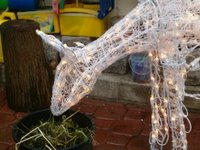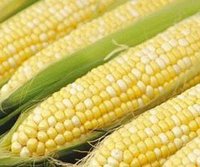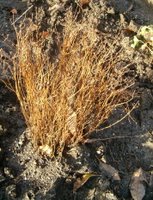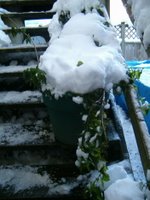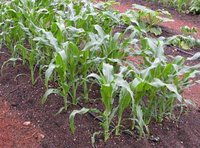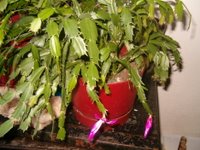

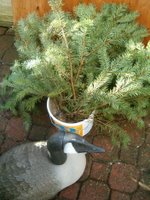
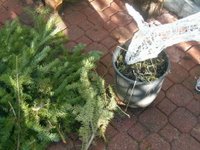



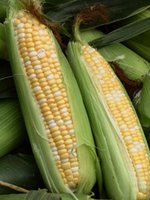
Winter on Gabriola, Summer Down Under
Our Christmas wreath is still on the door as the mild, drizzly Christmas weather is slowly being replaced by some freezing Arctic air. The Butterfly Bush thinks it’s spring, and is putting forth new shoots on its severely pruned branches.
Some herbs and weeds are still green after that last frost, and Hedgehog’s goose has found a new home in the courtyard, after being in our bathroom for so many years.
I was visiting a neighbor for a few minutes, put down my heavy winter coat on a chair in his kitchen, and one of his unneutered male cats sprayed on my coat in that short a time. I had to empty all my pockets when I got home so Sara could throw the coat in the washing machine.
In the meantime, I’m wearing a much thinner coat and I definitely feel the chill. I’ve mentioned before that I’m not a winter enthusiast. In fact, that invitation from John and Eloise sounds better and better each day.
Even though their corn is still young, I don’t think we’ll wait for harvest. Since we’re homeschooling both Jim and Hedgehog this year, taking the kids to New Zealand for a few weeks would not be a problem. In fact, it could be a marvellous learning experience for them!
I have to discuss this plan with Sara. Also, it somehow has to fit the family budget, which right after Christmas won’t be easy. Four tickets to Down Under can cost a fortune, unless I’m able to find a super deal on the Internet.
I escape once more to the warmth of my den and check my e-mail. Our New Zealand family is being active as ever. Eloise is worried about the watering regimen for the sweet corn that they’re growing organically down there.
They’ve taken our advice and are using 100% organic products from Advanced Nutrients, absolutely the best plant nutrient company on the planet. Their basic ferts are Iguana Juice Grow and Bloom, which fed Sara’s beautiful flowers, pictures of which can be viewed in the archives of this blog.
Sweet corn grows best when the soil pH is between 6.0 and 6.8. According to Advanced Nutrients, the preferred soil pH is 6.3. Eloise says that John measures their soil pH every day, sometimes twice a day. If it’s off even by a tad, he adjusts it by adding pH Up or pH Down, two very handy Advanced Nutrients products designed for that purpose.
Eloise writes: “Even though we planted our corn on half an acre only, we have about 7,000 plants. We planted deeper than what the guide book says—they recommend an inch down for the seeds—because it gets quite windy around here and corn plants have shallow roots.”
“We heard that it got quite windy in British Columbia, as well. Lucky that falling tree on your property was leaning away from your house. It’s not that bad here this summer, but the windstorms usually happen in July.”
If you’re doing a double take while reading this, you have to remember that the seasons are exactly the opposite Down Under to ours. Right now they’re going to the beach to celebrate Christmas and New Years.
Eloise continues: “Corn requires about an inch of water per week. I mentioned that we have good draining soil, and our watering tank is hooked up to hoses attached to a pump. We mix all our nutrients and additives in a pre-mix tank, then we pour it into our main water tank.”
“Although our summer is on the cool side—temperatures around 18° Celsius (64° Fahrenheit)—thanks to your nutrient suggestions, our corn and vegetables have been growing faster than anything we’ve grown in the past. Our corn is up to my waist and I’m nearly six feet.”
“My concern about watering is that with all the precipitation we’ve been having, are we watering too much. The Advanced Nutrients chap told us—when in doubt, let it dry out. So we’re trying to follow his advice, but at the same time make sure that our plants are getting their weekly inch of water. Corn does not relate well to drought conditions.”
“We’ve also had some deer jump our deer fence at its lowest point—the fencemaker couldn’t make it any higher on an embankment. So we’ve hung some sacks of blood meal on the fence posts. That’s supposed to deter them.”
“The crows are bad enough, we don’t want to lose any of our crop to the deer. John has purchased a contraption from a catalogue that has a motion sensor and makes a noise and shoots water at the crows if they come around.”
“I’ve been cultivating like crazy around the corn to remove the weeds, which can attract parasites of every kind. As I mentioned before, we’re using Barricade continuously and John never stops spraying with Scorpion Juice.”
“Knock on wood, so far we’ve managed to avoid the common problems associated with growing corn. We’re inspecting our plants on a daily basis to check for root rot “
“BTW the root colonizers you suggested have doubled the size of our rootballs—we’re following the Nutrient Calculator in administering Piranha, Tarantula, and Voodoo Juice every third week only, during this vegetative stage of our vegetables. We know that these Advanced Nutrients additives ward off many of the pests and diseases that corn is vulnerable to.”
“We also have to keep an eye out for wireworms or white grubs, but these are usually found in soil that had been planted previously with alfalfa, which ours hadn’t been.”
“Once the tassels pollinate the mature ears, we’ll have to be aware of Corn Smut, an insidious fungus that causes swelling in the kernels and evil looking color changes from yellow to grey to black.”
“European Corn Borers are perhaps the best-known pest of sweet corn. Believe it or not, the cream-colored larvae are about an inch long! They start by chewing their way into the stalks and weakening them until some of them break. Then they wind up in the corn cob.”
“Thank goodness, so far we’ve managed to avoid these parasitical pests for the most part, although our peppers had a brief infestation of spider mites. Out came the spritzer with the Scorpion Juice, and the mites were history.”
“Must sign off now, before John comes in from the fields asking for his supper. No matter how advanced we get in New Zealand, it’s still up to the wife to feed her husband. I know that you do a lot of the cooking in your family, Tim. We must bring you over here to give John lessons.”
As I’ve said, her invitations sound more and more enticing.
posted by Tim at
9:25 PM
|
0 comments
![]()

